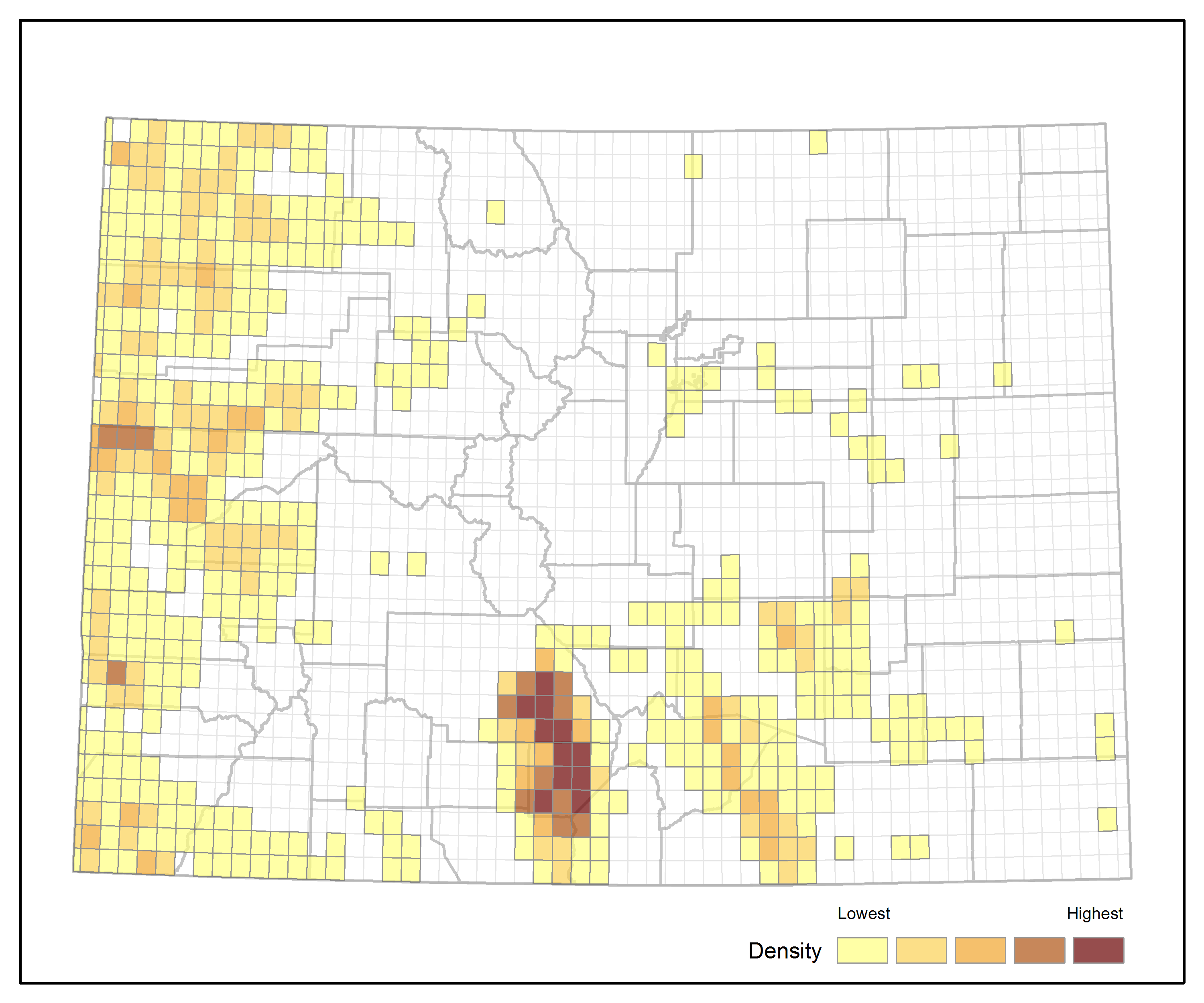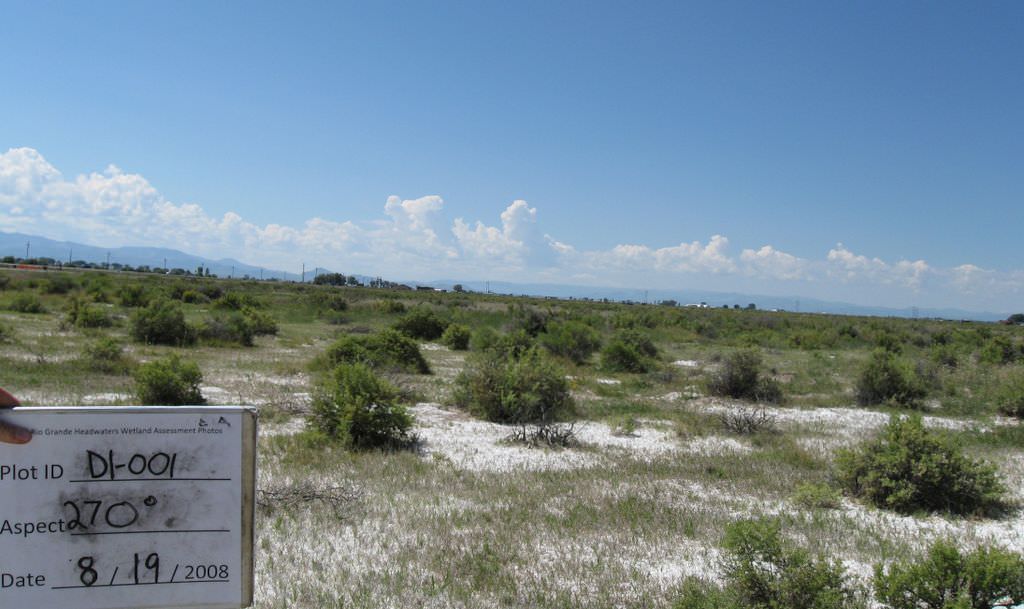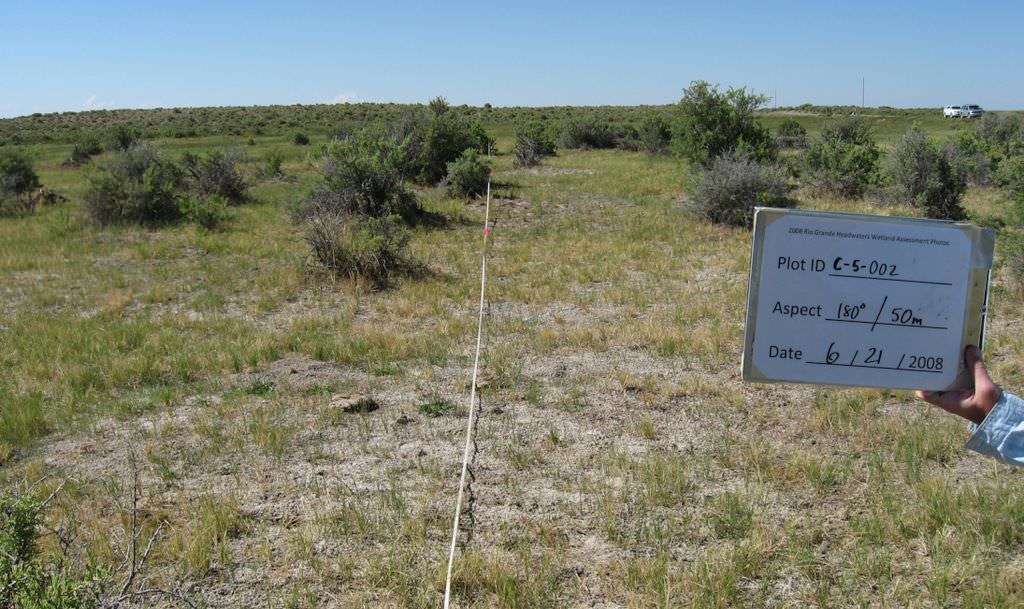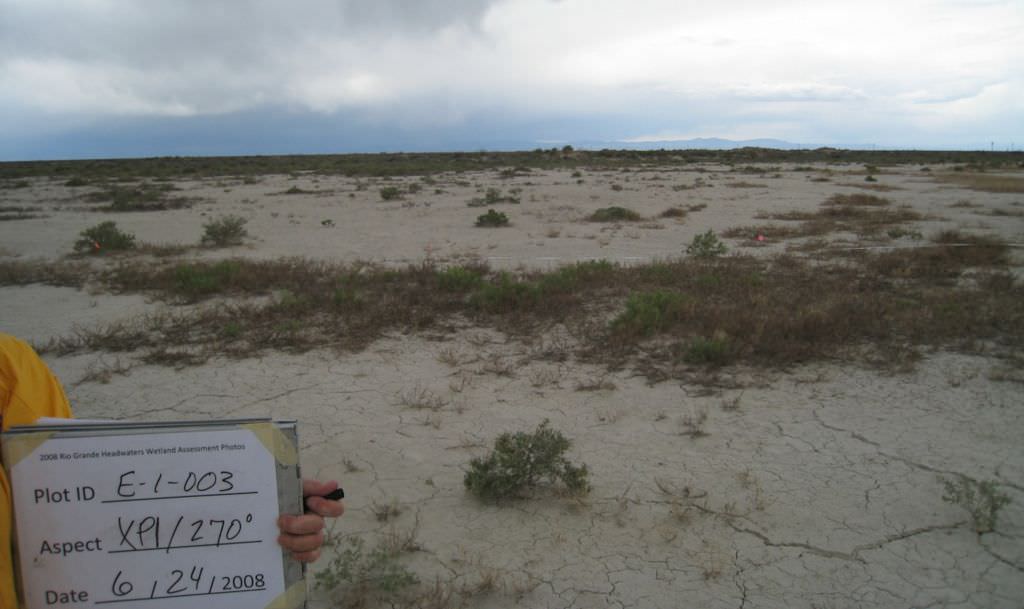Inter-Mountain Basins Greasewood Flat
Click link below for details.
General Description
The Inter-Mountain Basins Greasewood Flat ecological system occurs throughout the Intermountain West and extends onto the western Great Plains and central Montana. Greasewood flats are a large patch system confined to specific environments defined by hydrologic regime, soil salinity and soil texture. These cold, semi-desert shrublands are typical of arid, continental environments with hot summers, cold winters and low annual average precipitation. This system typically occurs near drainages on stream terraces and flats or may form rings around more sparsely vegetated playas. Sites typically have saline soils, a shallow water table and flood intermittently, but remain dry for most of the growing season. However, the water table remains high enough to maintain vegetation, despite salt accumulations. This system usually occurs as a mosaic of multiple communities of open to moderately dense shrublands dominated or codominated by black greasewood (Sarcobatus vermiculatus). Other shrubs that may be present or codominant include four-winged saltbush (Atriplex canescens), shadscale (Atriplex confertifolia), Gardner's saltbush (Atriplex gardneri), Wyoming sagebrush (Artemisia tridentata ssp. wyomingensis), Basin big sagebrush (Artemisia tridentata ssp. tridentata), Plains silver sagebrush (Artemisia cana ssp. cana), or winterfat (Krascheninnikovia lanata). Occurrences are often surrounded by mixed salt desert scrub or big sagebrush shrublands. The herbaceous layer, if present, is usually dominated by graminoids. There may be inclusions of alkali sacaton (Sporobolus airoides), western wheatgrass (Pascopyrum smithii), inland saltgrass (Distichlis spicata), sand reedgrass (Calamovilfa longifolia), Kentucky bluegrass (Poa pratensis), Nuttall's alkali grass (Puccinellia nuttalliana), or creeping spikerush (Eleocharis palustris) herbaceous types.
Diagnostic Characteristics
This system is characterized by shrublands dominated or co-dominated by black greasewood (Sarcobatus vermiculatus) that occur in the lower foothills and valley bottoms of the Intermountain West. On alkaline soils, black greasewood can be found in nearly pure stands or, in less alkaline soils, black greasewood may intermix with other shrubs such as shadscale, four-winged saltbush, sagebrush or rabbitbrush.
Similar Systems
Similar systems also include upland sagebrush (Artemisia spp.) and saltbush (Atriplex spp.) shrub systems.
Range
This system occurs throughout the Intermountain West and extends onto the western Great Plains and central Montana. In Colorado, large occurrences are found in the lower elevations of Colorado's western valleys and throughout much of the San Luis Valley. In eastern Colorado, occurrences are primarily in the southwestern portion of plains.
Ecological System Distribution

Spatial Pattern
Inter-Mountain Greasewood Flats is a large patch system.
Environment
Greasewood flats are a large patch system confined to specific environments defined by hydrologic regime, soil salinity and soil texture. These systems are maintained by groundwater and are typically found near drainages on stream terraces and flats, on alluvial fans along streams or arroyos, or they may form rings around playas. Sites usually have saline soils, a shallow water table and flood intermittently, but remain dry for most of the growing season. The water table however remains high enough to maintain vegetation, despite salt accumulations. Environmental conditions in the cold deserts select for those few species that are adapted to moisture deficits, low temperatures and salinity. Black greasewood (Sarcobatus vermiculatus) is a facultative halophyte that is tolerant of alkaline and saline soil conditions, which allows the species to occur in sites with less interspecific competition. Greasewood is also found on arid, non-saline sites where it mixes with other shrubs such as shadscale, four-winged saltbush, rabbitbrush and winterfat.
Climate is distinctly continental and typified by warm summers and prolonged, cold winters with temperatures in January and February often well below freezing. Average precipitation is low, usually less than ten inches, with most precipitation falling in winter. Melting snow and spring rains result in the primary annual soil recharge although, except in years of unusually high summer rainfall, spring and summer precipitation is generally effective in only wetting the surface layers of the soil. Average temperatures and precipitation are similar between eastern and western regions of Colorado where this system occurs, but timing of precipitation differs; much of the annual precipitation on the Great Plains comes from convectional storms originating in the Gulf of Mexico during summer, while in western sites, summer precipitation is much less important. Seasonal photosynthetic activity is largely limited to spring and early summer, corresponding with the season of highest moisture, although, even during late summer, cold desert shrubs are able to extract moisture from soils with very low water potential.
Hydrologic regime is a key factor controlling vegetation composition and soil development in all wetlands. Greasewood flats are tightly associated with saline soils and groundwater that is near the surface, thus the primary hydrologic process that maintains greasewood flats is groundwater recharge. Black greasewood is phreatophytic and its distribution is well correlated with the distribution of groundwater but also with the amount of exchangeable sodium and the percent of water retained at field capacity. Black greasewood stands develop best where moisture is readily available, either from surface or subsurface runoff, and is often found on sites with high water tables (less than 34 feet) that are intermittently flooded or that have a high water table at least part of the year. Water from brief summer thunderstorms does not easily infiltrate these shale soils, so runoff on slopes tends to accumulate in depressions. High evaporation rates during the hot, dry conditions lead to a concentration of salts, which may actually form a white crust on the soil surface where water accumulates in these low spots.
Soils supporting black greasewood are variable, but are typically alkaline or saline and can include silt-clays, clay-loams, silt-loams, or deep fine sand-loams, though this species is most commonly associated with heavy textured clay and silt soils of high salt content (0.05-1.6%). However, black greasewood can be found growing on non-saline soils and so is not an infallible indicator of high salt content. Plant species distribution in this system is often determined by degree of soil salinity and soil moisture. For instance, greasewood is extremely salt tolerant but is limited to moist habitats or areas with accessible ground water, whereas sagebrush (Artemisia tridentata) is only a moderately salt tolerant xerophyte and saltbush (Atriplex spp.) species can tolerate both the combined stresses of low soil moisture and salinity. In the inter-mountain basins, black greasewood is often confined to alkali soils on alluvial areas, floodplains, dry washes, and gullies where soil moisture is high, as compared to desert regions where it often dominates areas where runoff waters have accumulated.
Vegetation
This ecological system usually occurs as a mosaic of multiple communities of moderately dense shrublands dominated or codominated by black greasewood (Sarcobatus vermiculatus). On saline sites with consistently high water tables, greasewood may grow in nearly pure stands or in association with saltbushes (Atriplex spp.), whereas on less saline sites, greasewood may occur with several other shrub species. Shrubs commonly codominant or present with black greasewood include four-wing saltbush (Atriplex canescens), shadscale (Atriplex confertifolia), rabbitbrush (Chrysothamnus nauseosus), cholla (Cylindropuntia imbricata), or winterfat (Krascheninnikovia lanata). The herbaceous layer, if present, is usually dominated by graminoids such as alkali sacaton (Sporobolus airoides), inland saltgrass (Distichlis spicata), and blue grama (Bouteloua gracilis). Small patches of pure alkali sacaton, inland saltgrass, or creeping spikerush (Eleocharis palustris) herbaceous types may also be found within the shrubland system where water remains ponded the longest.
Greasewood dominated vegetation can occur as a narrow band along a channel, or in a mosaic of communities where composition and density of the shrub and understory species vary with depth to water table, salinity and alkalinity, soil texture, and past land use or disturbance. Occurrences may be surrounded by grasslands, stabilized sand dunes, wet meadow systems, mixed salt desert scrub, sandsage, or shortgrass prairie. Hanson (1929) described stands in south-central Colorado and found that pure stands of black greasewood (S. vermiculatus) and inland saltgrass (D. spicata) are more common on strongly saline/alkaline sites with fine-textured soil and shallow water tables, whereas stands with mixed shrubs such as rabbitbrush (Chrysothamnus spp.) or sagebrush (Artemisia spp.) are more common on drier, coarser textured, low-alkaline sites. Alkali sacaton (S. airoides) is found on dry, strongly alkaline sites, and western wheatgrass (Pascopyrum smithii) is most common on less alkaline, moist sites in low lying areas.
- CEGL001313 Atriplex confertifolia - Sarcobatus vermiculatus Shrubland
- CEGL001773 Distichlis spicata - (Scirpus nevadensis) Alkaline Wet Meadow
- CEGL001770 Distichlis spicata Alkaline Wet Meadow
- CEGL001833 Eleocharis palustris Marsh
- CEGL002918 Ericameria nauseosa / Sporobolus airoides Shrubland
- CEGL001481 Leymus cinereus - Distichlis spicata Alkaline Wet Meadow
- CEGL001479 Leymus cinereus Alkaline Wet Meadow
- CEGL001799 Puccinellia nuttalliana Salt Marsh
- CEGL001999 Salicornia rubra Salt Flat
- CEGL001359 Sarcobatus vermiculatus / Artemisia tridentata Wet Shrubland
- CEGL001360 Sarcobatus vermiculatus / Atriplex gardneri Wet Shrubland
- CEGL001361 Sarcobatus vermiculatus / Bouteloua gracilis Wet Shrubland
- CEGL001363 Sarcobatus vermiculatus / Distichlis spicata Wet Shrubland
- CEGL002919 Sarcobatus vermiculatus / Juncus arcticus ssp. littoralis Sparse Vegetation
- CEGL001367 Sarcobatus vermiculatus / Pseudoroegneria spicata Shrubland
- CEGL001368 Sarcobatus vermiculatus / Sporobolus airoides Wet Shrubland
- CEGL001370 Sarcobatus vermiculatus / Suaeda moquinii Wet Shrubland
- CEGL001687 Sporobolus airoides - Distichlis spicata Wet Meadow
- CEGL001685 Sporobolus airoides Southern Plains Wet Meadow
- CEGL005417 Suaeda calceoliformis Wet Meadow
Associated Animal Species
Environmental conditions are rigorous in these cold, semi-desert shrublands. Regardless, numerous animal species thrive here due to distinct adaptations that enable survival in these regions. Common mammal species include black-tailed jackrabbit (Lepus californicus) for whom greasewood is an important forage, badger (Taxidea taxus), white-tailed antelope squirrel (Ammospermophilus leucurus), Gunnison's and white-tailed prairie dogs (Cynomys gunnisoni and C. leucurus), Ord's kangaroo rat (Dipodomys ordii), mule deer (Odocoileus hemionus) and pronghorn (Antilocapra americana). Reptile species are common and include sagebrush lizard (Sceloporus graciosus), side-blotched lizard (Uta stansburiana), western whiptail (Cnemidophorus tigris), striped whipsnake (Masticophis taeniatus), Great Basin gopher snake (Pituophis melanoleucus deserticola) and bullsnake (Pituophis catenifer).
Greasewood Flats provide a bounty of resources for avian fauna. Due to this system's structural and floristic simplicity, bird diversity and density are typically low, but in the washes where greasewood becomes dense and tall, the density and diversity of birds matches that of the mountain shrub zone. In the best developed greasewood habitat, typical nesting species include Horned Lark (Eremophila alpestris), Mourning Dove (Zenaida macroura), Western Meadowlark (Sternella neglecta), Northern Mockingbird (Mimus polyglottos), Loggerhead Shrike (Lanius ludovicianus), Black-throated Sparrow (Amphispiza bilineata), Lark Sparrow (Chondestes grammacus), Sage Thrasher (Oreoscoptes montanus), Sage Sparrow (Artemisiospiza nevadensis), and Brewer's Sparrow (Spizella breweri). These shrublands provide important hunting grounds for a variety of raptors including Golden Eagle (Aquila chrysaetos), Ferruginous Hawk (Buteo regalis), Prairie Falcon (Falco mexicanus), Northern Harrier (Circus cyaneus), and Swainson's Hawk (Buteo swainsoni). Lark Buntings (Calamospiza melanocorys) are irruptive breeders in semidesert shrubland outside of their usual range. In a rare year these buntings suddenly appear on the desert, becoming locally common.
Dynamic Processes
Groundwater flows and depth of the water table are among the most important driving factors in maintaining this system. Successional status of black greasewood varies with moisture and soil conditions. Under moist-sodic edaphic conditions, black greasewood is described as a "stable dominant and is probably the climax vegetation of very alkaline soils. A study of saline prairie sites in Canada found black greasewood occurred exclusively on undisturbed sites. However, black greasewood is also known to sprout after disturbance and will invade nearby rabbitbrush and saltbush stands if the water table of these stands rises, making it an early successional community in this situation. With increasing soil salinity (>1.08%) black greasewood is replaced by species such as inland saltgrass.
Black greasewood community types were historically subject to stand-replacing fire regimes with intervals estimated at <35 to <100 years. Historically, saltbush/black greasewood communities had sparse understories and bare soil in intershrub spaces, making these communities somewhat resistant to fire except in years of high fire hazard conditions such as may occur with drought. Fire return intervals have been altered by grazing and by weed invasion. Grazing results in increased biomass production due to sprouting and increased seed production, leading to greater fuel loads and an altered fire regime. Throughout vast areas of the western rangeland invasion by annual grasses, such as cheatgrass (Bromus tectorum) has also resulted in changes to the fire regime. In salt-desert shrublands, cheatgrass increases fine fuels, which increases fire frequency, which then results in long recovery periods and the prevention of the establishment of desert shrubs such as black greasewood.
Management
These shrublands have generally been used for grazing and some areas have been converted to agricultural production, such as has occurred in portions of the Grand Valley and the San Luis Valley. Livestock grazing in cold desert shrublands has often resulted in the breaking up of long-established soil crusts, enhanced erosion and contributed to the spread of non-native weeds such as cheatgrass. Cold deserts are often nitrogen poor. The major agent of atmospheric nitrogen fixation in cold deserts is the soil surface cryptogam crust, which is easily destroyed by livestock trampling. One of the greatest threats to biodiversity and system integrity is the introduction of non-native plants. Cheatgrass, a widespread non-native annual grass, is fire-prone and shortens fire return intervals, so native shrubs are replaced. Additionally, once cheatgrass becomes established on rangelands, it persists for decades and interferes with the reinvasion by native perennial plants, even when native taxa seed sources are present.
Global climate change in the southwest is resulting in increasing temperature, drought, wildfire, and invasive species that will accelerate transformation of the landscape. Trends in temperature regimes may alter the competitive relationships among plant species, and this will become a more urgent problem in the presence of invasive plant species such as cheatgrass. Record-setting wildfires are resulting from the rising temperatures and related reductions in spring soil moisture. Climate-fire dynamics will be affected by changes in the distribution of ecosystems and by increased availability of fine fuels. Increasing temperatures and shifting precipitation patterns will drive the expansion of drier ecological systems, another factor likely to increase fire risk.
Because this system is dependent on groundwater, groundwater depletion will likely impact system integrity. Development activities such as groundwater pumping and surface diversions will likely contribute to groundwater depletion. Groundwater recharge will also likely be impacted by global climate change which, in the southwest, is projected to experience longer and more severe droughts from the combination of increased evaporation and reduced precipitation.
References
- Andrews, R. R. and R. R. Righter. 1992. Colorado Birds. Denver Museum of Natural History, Denver. 442 pp.
- Branson, F. A., R. F. Miller, and I. S. McQueen. 1976. Moisture relationships in twelve northers desert shrub communities near Grand Junction, Colorado. Ecology 57:1104-1124.
- Caldwell, M. 1985. Cold Desert. In Physiological Ecology of North American Plant Communities. ed. B.F. Chabot and H.A. Mooney. p. 198-212. Chapman and Hall, New York. 351 pp.
- Colorado Partners in Flight. 2000. Land Bird Conservation Plan. http://www.blm.gov/wildlife/plan/pl-co-10.pdf.
- Daubenmire, R. F. 1970. Steppe vegetation of Washington. Washington State University Agricultural Experiment Station Technical Bulletin No. 62. 131 pp.
- Hanson, H. C. 1929. Range resources of the San Luis Valley. Pages 5-61 in: Range resources of the San Luis Valley. Bulletin 335. Colorado Experiment Station, Fort Collins, Colorado.
- Kingery, H. E., editor. 1998. Colorado Breeding Bird Atlas. Colorado Bird Atlas Partnership and Colorado Division of Wildlife, Denver, CO. 636 pp.
- Ungar, I. A., W. Hogan, and M. McClennand. 1969. Plant communities of saline soils at Lincoln, Nebraska. The American Midland Naturalist 82:564-577.
- Seastedt, T.R. 2002. Base Camps of the Rockies: The Intermountain Grasslands. Pages 219-236 in Rocky Mountian Futures: An Ecological Perspective. J.S. Baron, ed. Island Press, Washington, DC.









